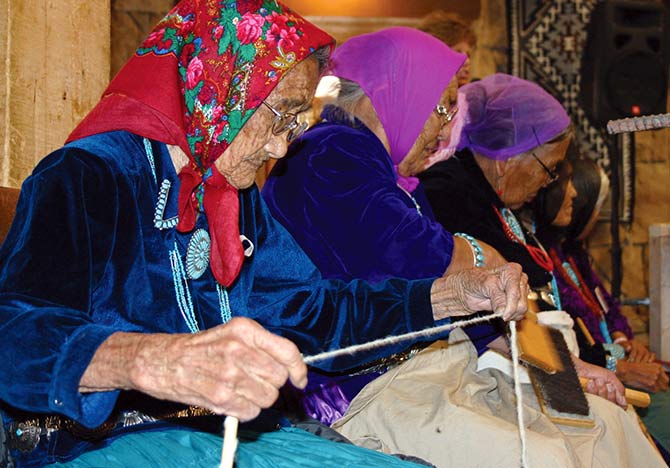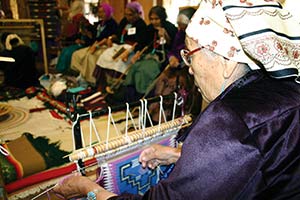'One mind, one heart, one prayer'

(Special to the Times - Althea John)
Showing different steps to make yarn for weaving, Carol Blackhorse, 93, of Black Mesa, Ariz., shows the audience how to spin wool at the 20th anniversary of the Adopt a Native Elder Program on Nov. 7 in Deer Valley, Utah.
Elders connect with supporters at 20th annual rug show
By Cindy Yurth
Tséyi' Bureau
PARK CITY, Utah, Nov. 19, 2009

(Special to the Times - Althea John)
Elizabeth Clah, of Many Farms, Ariz., demonstrates how to weave a rug at the Adopt a Native Elder Program in Deer Valley, Utah, on Nov. 7. Many elders attended the event to show the steps it takes to weave.
Katie Furcap usually walks with a cane. On Saturday, Nov. 7, she forgot it.
"I'm so happy, I didn't remember I need a gish," the 76-year-old from Big Mountain, Ariz., quipped in Navajo.
The miraculous occasion was the 20th Annual Adopt-a-Native-Elder Rug Show, in which Furcap has been participating since before it was even an official event.
Furcap wasn't the only one smiling at the packed Snow Park Lodge, where customers perused crafts and rugs and Diné elders, with a child or grandchild translating, explained the symbolism in their designs (including a new symbolic color: pink for breast cancer awareness).
This isn't your typical rug show. Over the event's three days, participants can meet the weavers, learn how to weave themselves, and see entertaining events like "Grandma Native American Idol."
For another thing, 100 percent of the proceeds go directly to the weavers or to their support. But that isn't the only reason Julius Chavez of Many Farms, Ariz., and his aunties like to sell their rugs here. It's the caliber of the clientele.
"The people who come to the rug show want more than just something pretty to hang on their wall," Chavez said. "They want to know the meaning of the design, the spirituality of weaving. They know this is a piece of someone's life, their joys and their suffering."
Humble beginnings
The rug show, which this year comprised about 30 families of weavers, more than 700 rugs and 200 volunteers from as far away as The Netherlands, has come a long way since its humble beginnings in 1989, when Adopt-a-Native-Elder founder Linda Myers brought four weavers up to Park City with their 12 rugs.
"We set up the rugs in the Kimball Art Center," recalled Aurelia Pederson, one of the sale's two original volunteers. "We didn't know if anyone would come."
They had underestimated the people of Park City. The 12 rugs sold within an hour, providing a winter's livelihood for the four weavers.
But the seed for the rug show was sown some years earlier, when a desperate Furcap handed Myers a rug. She had worked on it for months and the local trader had turned it down.
Myers found a buyer, and from then on the traditional elders of the program started turning out rugs for Myers to take back to Utah and sell.
To understand the Adopt-a-Native-Elder program, though, you have to go back further than that.
It was the early 1980s, and a young Diné woman named Grace Yellowhammer had decided she had had enough of California.
She headed back to her family home in Big Mountain, Ariz., only to discover it was no longer there. The family had been relocated during the apportionment of the Navajo-Hopi Joint Use Area in 1977.
Abandoned homes
Yellowhammer went back to Big Mountain to investigate. She found abandoned homes where, to her shock, women had left behind their grinding stones and weaving tools.
"I picked those stones, I picked those weaving tools and took them home," she said. "I thought, 'Their lives are over.'"
She also encountered a small group of Diné, mostly middle-aged and elderly women, who had refused to leave Big Mountain. Their grazing permits had been revoked, depriving them of their livelihood, and they were in horrible shape. One woman had no shoes; another had been evicted from her house and was living under a juniper tree.
Yellowhammer went to Window Rock and made a desperate appeal to the Navajo Nation government, but was told the leaders' hands were tied. They had agreed to the relocation and couldn't be seen as aiding the resistors.
"I thought, 'OK, I'll leave them alone then,'" Yellowhammer recalled. "If our government won't help our own people, I'll find someone who will."
Fellow activist Rose Hulligan introduced Yellowhammer to Myers, a Park City artist with an interest in Navajo weaving. As the women recounted the conditions on Big Mountain, Myers became more and more appalled.
"I'll help you," Yellowhammer recalls her saying.
Myers solicited donations of clothing, and before long some boxes arrived on Big Mountain. Yellowhammer gratefully tore into the first one.
"It was nothing but bikinis," she recalled.
One of the grandmas held up a bikini bra.
"What is this?" she asked. "Some kind of slingshot?"
Hopefully, Yellowhammer sliced into the second box. It was all high-heeled shoes. The elders didn't even recognize them as footwear.
"I had to explain to them in Navajo that people in the city don't walk much, and this is what they wear on their feet," Yellowhammer recalled.
One másáni asked if she could keep a platform sandal to use as a hammer.
"Needless to say, those two boxes went to the Goodwill," Yellowhammer laughed.
Serious about helping
But Myers learned from her mistakes. The next box contained material so the women could make their own clothes. That impressed Furcap, a Big Mountain resistor who had seen well-intentioned bilagáanas come and go.
"When we didn't wear the clothes we sent, she tried something else," Furcap said. "That's when I knew this lady is serious about helping us."
From those early days when Myers and a handful of volunteers caravanned their four-wheel-drives up the rutted road to Big Mountain, the program has grown steadily. According to Myers, Adopt-a-Native-Elder now serves 525 traditional elders between 70 and 108 years old all over the reservation.
It's a 501(c) 3 charity that, in spite of its roots in the land dispute, is non-political and exists only to help Navajo elders hold on to a traditional livelihood, she stressed.
There are many ways to help besides buying a rug. Individuals, classrooms or groups can "adopt" an elder, which means providing at least two food boxes per year for the program to deliver. Ted Reynolds, a retired Navy officer from Poway, Calif., is Katie Furcap's sponsor.
"She's a beautiful woman," Reynolds said, eliciting a shy grin from Furcap. "That's why I go along on all the food deliveries."
"He's on our side," said Darlene Furcap, Katie's daughter, of Reynolds. "He's always there for us. He even herds people over to our booth to look at our rugs."
Reynolds became intrigued with the Adopt-a-Native-Elder program after meeting some Navajos at a sheepdog demonstration at Soldier Hollow, Utah.
"I wouldn't have served in the Navy for 26 years if I didn't think this was the greatest country on earth," Reynolds said.
Helping the original Americans, to Reynolds, "is a way to continue to serve."
Other ways to help
For those who don't want the commitment of sponsoring an elder, there are many other ways to help: you can contribute a bundle of firewood, a skein of yarn, gift certificates to Wal-Mart, or food for the annual food runs, for instance, or stuff a Christmas stocking.
And for those who are more drawn to youth, there is the "For the Children" branch of the program that encourages Navajo youth to take up the traditional lifestyle.
Information on all the projects is available on the program's website, www.anelder.org.
Anything donated to the program is considered part of a traditional "giving circle," with no expectation of return. But that doesn't mean the donors aren't getting anything out of the process.
"We have become one voice, one mind, one heart, one prayer with the non-Indian people who are supporting us," said Yellowhammer. "These elders think about their supporters all year long. They pray for them. They put a lot of prayer into the rugs they make for the rug sale, so that they will bless the homes of the people who buy them."
"Everybody wins," summed up Adopt-a-Native-Elder board member John Burrow of Ogden, Utah. "The weavers get important additional income, we as volunteers get that good feeling that comes from helping people, and the people who come to the rug show end up with a treasure that their family will have forever."

